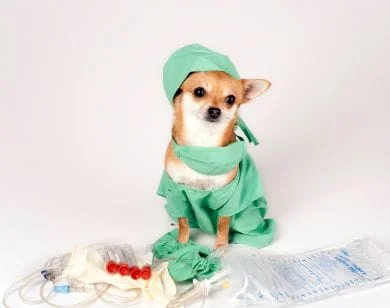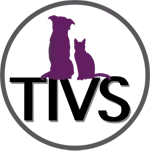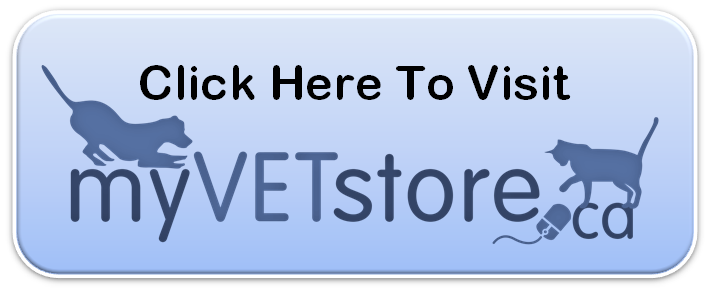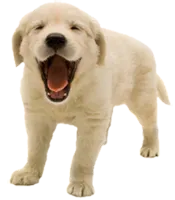
When you are looking for a veterinary care clinic you should be able to count on superior care and excellent service. We at Thousand Islands Veterinary Services in Gananoque ON have assembled an expert team of veterinary professionals to bring you the best possible healthcare for your pet. We have a well equipped facility which is clean, comfortable, and efficient. During our renovations we focused on making changes that would help our patients to feel more comfortable and be less inclined to be worried about seeing their doctor. Call 613-382-2900 to schedule an appointment and we will find a time that is convenient for you.
Once a year, you should bring your pet in for a check-up. This will include a full physical exam, and we will discuss any concerns that you may have or any changes or new developments in your pet's health since your last visit. Dr. Brian Willows or one of his associates will check the health of your pet from head to tail, and you will be very happy you came to Thousand Islands Veterinary Services for service. Bring in any medical history you have of your pet when you come to our vet clinic. It's best to keep a journal of your pet's health throughout his or her life, including behavioral shifts. If you have something like this, share it with our team. If not, let us know everything that you think will be important. Our doctor's can still work with whatever information you have.
What To Expect When Your Pet Has a Surgical Procedure at TIVS:
If your dog or cat needs to have a surgical procedure, rest assured that we take our jobs as his or her caretaker very seriously! Your pet’s health and comfort are our #1 priorities. We take great pride in the fact that ALL of our employees are well trained professionals who have taken focused schooling and training to make them well prepared to deal with everything from the most routine nail trim, to a serious medical emergency.
When you drop off your pet in the morning we’ll have a surgical consent form for you to read and sign. We’ll want to be sure that your pet has been fasted and we’ll double check any medications that he or she might be receiving. This is your opportunity to ask one of our Registered Veterinary Technologists or Technicians (RVTs) any more questions that you might have come up with about the surgery or procedure of the day. This RVT will be with your animal throughout the day and will be the technician who will be monitoring your pet’s vital signs throughout the surgery and during recovery.
Once all of your questions are answered, we will weigh your pet and take him/her to the prep area for the Veterinarian who will be performing the surgery to complete a thorough examination of your pet. At this time the Vet and the Tech discuss the surgery and any specifics relating to his/her surgery. If pre-anesthetic blood work is to be done, then we’ll take that blood sample then. While waiting for the blood work to be completed we will take your pet to our kennel room. Our kennel room has in floor heating and we take great care in having a thick, warm and comfortable bed ready and waiting for your pet. Once the blood work has been completed (if the Owner has chosen for it to be done), the Veterinarian looks over the results to be sure that there aren’t any abnormalities or results that would make anesthesia or surgery a higher risk than initially anticipated. Rest assured that if there are concerning blood results, you will be contacted immediately before we proceed with the planned surgical procedure. An abnormal test result doesn’t necessarily mean that we can’t proceed with the plan for the day, but it might mean that we choose a different anesthetic protocol. Having in-house blood work means that we can catch some medical issues, that wouldn’t necessarily be apparent on a physical exam, before we even start the anesthesia.
Once the Vet has OK’d to proceed with the anesthesia, then we’ll give your pet some sedation. This is called a ‘Pre-Med’ and we can tailor what drugs are used based on your pet’s health, age, or breed. This pre-med serves several purposes. A good pre-med: calms the pet and eases restraint and handling, it provides some pain control and muscle relaxation, it reduces the amount of other anesthetic drugs that would be needed, and it can even counteract some potential side-effects of your main anesthetic agents. And a well chosen pre-med will help to provide your pet with a smooth anesthesia and recovery from surgery. After giving the pre-med sedation, we will put your pet back into his or her kennel for 20-30 minutes to relax and allow the medication to work.
If you have chosen intra-operative IV Fluids (for some animals for some procedures IV Fluids may not be optional as it will be medically necessary), then we’ll place an IV catheter and start giving fluids. This catheter also serves as an easy way for us to administer the intravenous anesthesia and any other medications that might need to be given. We use the safest anesthetic protocols that are available. We don’t choose the cheapest anesthetics, we choose the ones with the fewest side effects or the ones that will suit your individual pet’s needs the best. Each patient is different, so we are prepared to tailor our anesthetic protocols accordingly. Once the IV anesthesia is given, then we will place an endotracheal tube that maintains your pet’s airway and serves as a way to get the animal to breathe in the anesthetic gas that will keep him/her sleeping throughout the surgical procedure.
Once your pet is fully anesthetized, then we shave the surgical area and fully cleanse and disinfect the area with a surgical prep. (For a dentistry, we can skip this step and move straight to the dentistry suite.) Then we move the animal to the table in the surgical suite where they will be laying on a heated pad to keep them warm. We use an IV fluid pump to make sure that your pet is receiving an appropriate amount of fluids to help maintain their blood pressure and we also have an IV fluid warmer that is used to keep the fluids entering the patient’s body warm.
We also use a monitoring device called a Cardell that will monitor respiratory rate, heart rate, blood pressure, ECG, and body temperature. Throughout the surgical procedure one of our fully trained Registered Veterinary Technologists or Technicians will be in the surgery room with your pet, monitoring his/her vital signs. Our RVTs (Techs) don’t rely completely on the monitoring equipment though and they will be closely observing your pet throughout the anesthetic and will be listening to their patient’s heart and lungs with their stethoscopes, as well as monitoring several other parameters that they have been trained to look for and understand.
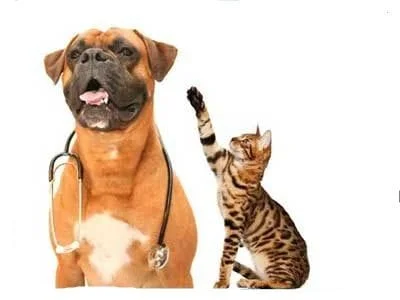
At the beginning of the anesthesia an injection of pain control medication will be administered so that when your pet wakes up, it is already beginning to work. Following the completion of the surgery, the Tech will not leave your pet’s side while he/she is waking up from the anesthetic. We don’t remove the endotracheal tube until your pet is able to swallow. This is very important to prevent any problems with regurgitation. If your pet seems to be in any pain, then the Tech will get the Veterinarian’s OK to administer further pain medication. Once your pet is able to swallow and the endotracheal tube is removed, then he/she is placed back into his/her kennel. We will have placed heating discs under the bedding in the kennel to make sure that your pet goes back in to a warm and cozy bed. We will also cover your pet up with a blanket to keep them warm as they can be chilled during the recovery from the anesthesia. Throughout the day, the surgery Tech will continue to keep a close eye on your pet to make sure that he or she is doing well and recovering as expected. The other staff members as well as the Vets will be coming and going and will peek in each time that they go by the kennel. Your pet won’t lack for attention while he/she is staying with us for the day!
The majority of our surgeries are done in the morning and your pet has the rest of the day to recover. Rest assured that if anything different comes up during surgery from the initial plan going into it, you will be called right away. This could be as simple as us discovering a tooth that needs to be extracted during a dentistry that we didn’t know about beforehand (our patients often are reluctant to open wide and say ‘ah’ before they are anesthetized, so sometimes we have to wait until then to know the full extent of the dental disease that our patient has), or it could be that we found a lump or mass that the doctor would like to remove that day as well. We will have gotten an emergency contact number from you when you dropped off your pet in the morning, so we would call that number and discuss what we’ve found with you before continuing and incurring any additional costs that you weren’t prepared for.
We will usually discharge our surgery patients around 4:00PM. We rarely keep routine surgery patients overnight as we know that you will watch them very closely at home and they will be more comfortable and less worried in their own home. We usually remove the IV catheter just prior to discharge time so that your pet can have the most benefit from the fluids as possible. The RVT who has been with your pet all day will go over take home instructions with you when you come in to pick up your pet. You will go home with a written list of things to watch for, how much food and water is allowed the night after surgery, how to monitor for signs of pain, how quiet your pet needs to stay, etc. This listing will also clearly explain any medications that you are sent home with. Usually this is just some post op pain medication for you to give over the next few days at home. The Tech will answer any of your questions that you might have. And if a follow-up visit is needed, she will book it then with you. All post-op rechecks are no extra charge. So if at any point you are concerned about an incision site or anything else, just call us and we’ll book a time for you to come in with your pet and one of our Vets will take a look.
It is also worth mentioning that we will give your pet a nail trim while he or she is anesthetized. There is no better time to do it than then!
One of our RVTs will call you within the next day or two following surgery to check in and see how your pet is doing post surgery. If at any point you are concerned though, we want to hear about it! So please never hesitate to call and ask us any questions.
We aim to usually only have 1 or 2 surgeries per day. This allows us to give your pet the one on one attention and monitoring that he/she deserves! This is what we feel the most comfortable with and we feel this is what our patients deserve.
If you have any further questions at any time, please always feel free to contact us at 613-382-2900! We are proud of the quality of our staff and the care that we provide. We know that your pets are your family and a surgical procedure is not all about the patient; we know that this is a nerve wracking time for you too! We all have our own pets and our goal is always to treat your pets how we would want our own to be treated.
